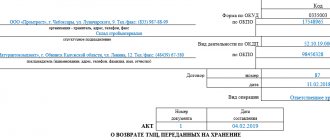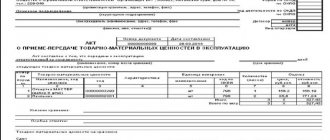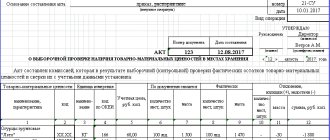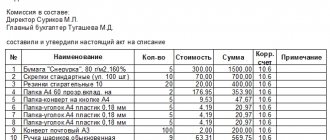If there are not enough own warehouse premises or they do not have the necessary conditions for storing goods, the organization can turn to a professional custodian. Read about how such operations are formalized in this article.
An enterprise can not only have its own warehouse, but also store products or inventory items (TMV) with another organization, including a professional custodian (for example, in a commodity warehouse).
The inventory storage process usually includes:
- acceptance (processing, including sorting) of cargo;
- organization of proper storage (creation of conditions to prevent damage, spoilage, to maintain the required temperature and humidity);
- constant monitoring and accounting of the movement of material assets;
- creating conditions to prevent the theft of material assets;
- return of goods and materials to the owner.
For manufacturing enterprises, such warehouses must, in addition, provide the production process with materials and components in a timely manner, complete the assembly of finished products, preserve them, pack them, prepare shipping documentation, and ship them.
Let's look at what documents are needed to document storage operations for products and inventory items.
Storage agreement
If an organization transfers inventory items (products) for storage to a professional custodian, for example, a warehouse, then it must conclude a storage agreement with the custodian in simple written form. Under such an agreement, the organization transferring property for storage acts as a bailor, and the organization accepting inventory items for storage acts as a custodian. In this case, the depositor remains the owner of the goods and materials transferred for storage.
Custodians can be legal entities (commercial or non-profit organizations) or individuals, and storage can be either the main or minor purpose of their activities. Storage of inventory items by professional custodians is carried out, as a rule, on a paid basis.
The agreement can provide for the following payment options for the custodian’s services: one-time payment upon termination of the storage agreement; payment by periods, paid at the end of each period (ten-day, monthly, quarterly, etc.).
A storage agreement in accordance with Chapter 47 of the Civil Code of the Russian Federation can be concluded with or without specifying a storage period, i.e. "poste restante". The storage agreement, as a rule, stipulates the storage conditions (storage location, method, temperature conditions, etc.).
In some cases, the storage agreement may provide that inventory items of one bailor may be mixed with inventory items of the same type and quality of another bailor. This type of storage is called anonymized storage.
With such an agreement, inventory items of the same type and quality are returned to the depositor, and these may not be the same inventory items that were transferred to him for storage, for example, in the case of grain storage in elevators or fuel storage in oil storage facilities.
The custodian is obliged to return the stored goods and materials at the end of the contract, as well as at the first request of the bailor, even if the contract has not expired. But if the bailor has paid the custodian the full amount of remuneration and takes the inventory items earlier than the period stipulated by the contract, the payment for the remaining storage period is not returned to the bailor.
The obligation to store goods may arise not only under a storage agreement, but also as an addition to another obligation. For example, if a buyer refuses a product transferred to him by a supplier, he is obliged to ensure the safety of this product (secure storage) until it is returned to the supplier.
Address storage system
In order not to waste a lot of time searching for stored products and quickly perform loading and unloading operations, cargo storage must be clearly systematized. Now the most popular is the address storage system.
Its idea is quite simple: each warehouse zone, section, rack, shelf or even cell is assigned its own letter or number. By arranging them in a certain order, you can accurately indicate the storage address of the goods. It will be registered in all documents that accompany the cargo.
The length of the address depends on the size of the warehouse and the volume of cargo placed. For example, the address F0813 may mean that the product is placed in storage area F, on rack No. 08, in the first section, on the third shelf.
Dynamic addresses
If the address storage system uses dynamic addresses, then the arrived goods are located in free space, and their addresses are assigned to the received cargo. The advantages of this method are, firstly, the efficient use of warehouse volume. Secondly, clear and understandable trade turnover. By viewing the software used in the warehouse, you can quickly and easily see the demand for products.
However, there are also disadvantages. If for some reason the program crashes, it will be difficult to find placed loads. In addition, only experienced storekeepers who have a good knowledge of the product range and warehouse space can successfully work with dynamic addresses.
Static addresses
You can allocate a permanent place for each type of product, then the addresses will remain unchanged. The advantages of this method include the ease of use of the system: even inexperienced warehouse workers can easily figure out the location of products, so acceptance and shipment will take place quickly. However, when a large quantity of goods arrives, difficulties arise with its placement and rotation.
After choosing the type of address storage, you should: draw up a diagram where the addresses will be indicated (sometimes it is convenient to do this in tabular form); enter addresses into the product specifications; fill out the database; label products. Then you need to mark the warehouse objects and put the corresponding letters or numbers on them in bright colors. Signs can be attached to racks and shelves.
The diagram of dividing the warehouse complex into zones should be placed in a visible place. When using a static storage method, you can immediately indicate the names of products. If everything is done properly, then any storekeeper or loader will be able to find the cargo without even imagining its type.
Storage in a warehouse
A commodity warehouse is an organization (entrepreneur) that carries out the storage of goods as a business activity and provides services related to storage.
A wide variety of goods can be stored in warehouses. As a rule, each warehouse is equipped with equipment designed to store a certain type of goods. One type of warehouse is a public warehouse.
A special feature of storage in a warehouse is the inspection of goods by the warehouse upon receipt and during storage. Inspection of goods, determination of their quantity and external condition in accordance with Article 909 of the Civil Code of the Russian Federation are the responsibility of the warehouse, unless otherwise provided by the contract, and such verification is carried out at the expense of the custodian. Inspection by the custodian of goods when they are transferred for storage is important to determine the degree of culpability of the custodian in the event of loss or damage to goods during storage.
The responsibility of the warehouse is also to provide the goods owner with the opportunity, during storage, to inspect the goods or samples of goods, if de-identified storage takes place, to take samples and take the necessary measures for the safety of the goods.
In accordance with the general provisions on storage, if it is necessary to change the conditions of storage of goods, the bailee is obliged to immediately notify the bailor. When stored in a warehouse in accordance with Article 909 of the Civil Code of the Russian Federation, to ensure the safety of goods, the custodian has the right to independently decide to change the storage conditions. The obligation to notify the goods owner occurs if a significant change in storage conditions is required.
When storing goods, damage to the goods may occur not only within the normal limits of damage, but also beyond these limits and the limits agreed upon in the contract. In this case, the warehouse is obliged to immediately draw up a damage report and notify the goods owner on the same day.
If, upon receipt of goods at the warehouse, their inspection and verification of quantity are the responsibility of the warehouse, then when returning the goods to the goods owner, both the warehouse and the goods owner have the right to demand inspection of the goods and verification of their quantity. In this case, the costs are borne by the party who requested the inspection or quality control of the goods.
If neither party has expressed its desire to inspect the goods and check its quality and these actions have not been carried out, a statement of shortage or damage to the goods due to improper storage is made to the warehouse in writing either upon receipt of the goods or within three days , if the shortage or damage could not be detected by the usual method of receiving the goods. If the owner of the goods does not make a statement to the custodian within the specified period, it is considered that the goods are returned in accordance with the terms of the contract.
Storage in a warehouse
One type of storage is storage in a commodity warehouse, and in the Civil Code of the Russian Federation (hereinafter referred to as the Civil Code of the Russian Federation), this type of storage is regulated by Articles 907 - 918 of the Civil Code of the Russian Federation.
In accordance with Article 907 of the Civil Code of the Russian Federation, a commodity warehouse is an organization that carries out the storage of goods as a business activity and provides services related to storage. A warehousing agreement is a paid agreement. According to it, a professional custodian who has the necessary equipment, which in this case will be a warehouse, and a staff of employees undertakes, for a fee, to accept goods from the bailor, store them and return these goods safely.
A wide variety of goods can be stored in commodity warehouses and, as a rule, each warehouse is equipped with equipment designed for storing a certain type of goods.
One type of warehouse is a public warehouse. A storage agreement concluded by a public goods warehouse is recognized as a public contract. This means that a public warehouse must accept goods for storage from each bailor who applies to it, and does not have the right to give preference to one bailor over another, except in cases established by law and other legal acts. Refusal to conclude a storage agreement is not allowed, except in cases where the custodian does not have the necessary equipment to store any type of goods; for example, an oil storage facility will not be able to conclude an agreement for the storage of grain, since it will not be able to ensure its safety. The remuneration for storage should be the same for all depositors.
A feature of storage in a commodity warehouse is the inspection of goods by the warehouse upon receipt and during storage.
Inspection of goods, determination of their quantity and external condition in accordance with Article 909 of the Civil Code of the Russian Federation are the responsibility of the warehouse, unless otherwise provided by the contract, and such inspection is carried out at the expense of the custodian. Inspection by the custodian of goods when they are transferred for storage is important to determine the degree of culpability of the custodian in the event of loss or damage to goods during storage.
The responsibility of the warehouse is also to provide the goods owner with the opportunity to inspect goods during storage or samples of goods if storage is de-identified, take samples and take the necessary measures for the safety of goods.
In accordance with the general provisions on storage, if it is necessary to change the conditions of storage of goods, the bailee is obliged to immediately notify the bailor. When stored in a warehouse in accordance with Article 909 of the Civil Code of the Russian Federation, to ensure the safety of goods, the custodian has the right to independently decide to change the storage conditions. The obligation to notify the goods owner occurs if a significant change in storage conditions is required.
When storing goods, damage to the goods may occur not only within the normal limits of damage, but also beyond these limits and the limits agreed upon in the contract. In this case, the warehouse is obliged to immediately draw up a damage report and notify the goods owner on the same day.
If, upon receipt of goods at the warehouse, inspection of the goods and checking their quantity are the responsibility of the warehouse, then when returning the goods to the owner, both the warehouse and the goods owner have the right to demand inspection of the goods and verification of their quantity, and the costs are borne by the party that requested the inspection or verification of the quality of the goods.
If neither party has expressed its desire to inspect the goods and check its quality, and these actions have not been taken, a statement of shortage or damage to the goods due to improper storage is made to the warehouse in writing upon receipt of the goods or within three days, if the shortage or damage could not be detected by the usual method of receiving the goods. If the owner of the goods does not make a statement to the custodian within the specified period, it is considered that the goods are returned in accordance with the terms of the contract.
DOCUMENTS CERTIFYING THE CONCLUSION OF A STORAGE AGREEMENT
Let's stop at the conclusion of the contract. The warehouse and the depositor, who transfers the goods for storage, enter into an agreement, the written form of which is considered complied with if the conclusion of the agreement and the acceptance of the goods for storage are certified by a warehouse document. The types of warehouse documents are given in Article 912 of the Civil Code of the Russian Federation:
double warehouse receipt;
simple warehouse receipt;
warehouse receipt.
Double warehouse receipt
consists of two parts - a warehouse receipt and a certificate of pledge (warrant), which are separated from each other. In accordance with Article 913 of the Civil Code of the Russian Federation, in each part of the double warehouse receipt, the following is indicated:
name and location of the warehouse that accepted the goods for storage;
current warehouse receipt number;
the name of the legal entity or citizen who is the bailor, as well as the location of the owner of the goods;
name of the accepted product, its quantity indicating the number of units and (or) measure of the product;
the shelf life of the goods or an indication that the goods are stored until required;
the amount of remuneration or the tariffs on the basis of which it is determined, the payment procedure;
date of issue of the warehouse receipt.
Both parts of the document must have identical signatures of the authorized person and the seal of the warehouse. A document that does not contain the necessary details, signatures and seals is considered invalid.
Simple warehouse receipt
on the basis of Article 917 of the Civil Code of the Russian Federation, it consists of one document issued to bearer and must contain the same details as a double warehouse receipt, except for the name of the legal entity or citizen who is the depositor, as well as the location of the owner of the goods. The document must indicate that it is issued to bearer. A document that does not contain the necessary details, signatures and seals is not a simple warehouse receipt.
Warehouse receipt
or a warehouse receipt is a document handed over by the warehouse to the depositor and confirming the acceptance of goods for storage for a certain period and for a specified fee for the goods specified in it. A warehouse receipt is issued either to the owner of the goods himself or to a person acting under a duly executed power of attorney.
According to paragraph 3 of Article 912 of the Civil Code of the Russian Federation, a double warehouse receipt, each of its two parts, as well as a simple warehouse receipt are securities. The definition of a security is contained in Article 142 of the Civil Code of the Russian Federation. In accordance with it, a security is a document certifying, in compliance with the established form and mandatory details, property rights, the exercise and transfer of which is possible only upon presentation. With the transfer of a security, all rights certified by it are transferred in the aggregate (Article 142 of the Civil Code).
RIGHTS OF WAREHOUSE DOCUMENT HOLDERS
Goods accepted for storage under a double or simple warehouse certificate may, during its storage in a warehouse, be the subject of a pledge agreement by transferring the corresponding certificate as collateral.
Article 914 of the Civil Code of the Russian Federation defines the rights of holders of warehouse and pledge certificates, and these documents can be held by one person or by different persons. The rights of the holders of these documents are different.
The holder of the warehouse receipt has the right to dispose of the goods, but the goods themselves continue to remain in the warehouse and cannot be taken from there until the loan issued under the pledge certificate is repaid. The transfer of the warehouse receipt to the new holder is carried out by an endorsement called an endorsement.
The holder of the pledge certificate, if he is not the same person as the holder of the warehouse receipt, has the right to pledge the goods in the amount of the loan issued under the pledge certificate and interest on it. When pledging goods, an endorsement is also made on the warehouse receipt.
The holder of the pledge and warehouse certificate has the right to dispose, in full, of the goods stored in the warehouse.
A double warehouse receipt and each of its parts, according to subparagraph 3 of paragraph 1 of Article 145 of the Civil Code of the Russian Federation, are order securities, since the rights certified by them may belong to the person named in the security, as well as to another authorized person appointed by this person.
We have already mentioned that rights under an order security are transferred by making an endorsement on it. The person who transferred the order security is called the endorser, and is responsible not only for the existence of the right, but also for its implementation. The person to whom the security is transferred is called the endorser.
According to paragraph 3 of Article 146 of the Civil Code of the Russian Federation, endorsement can be:
blank, that is, without indicating the person to whom the execution should be performed;
order, that is, indicating the person to whom or by whose order the execution should be carried out.
An endorsement may be limited only to an instruction to exercise the rights certified by a security, without transferring these rights to the endorsee (authentic endorsement). In this case, the endorsee acts as a representative.
Goods can be released from the warehouse:
to the holder of the warehouse and pledge certificates, and issuance is made only in exchange for both of these certificates together. The holder has the right to demand the release of the goods in parts, in this case the warehouse issues him new certificates for the goods that remain in the warehouse;
to the holder of a warehouse receipt who does not have a pledge certificate, but who has paid the amount of the debt under it. The goods are issued in exchange for a warehouse certificate, while its holder must simultaneously submit a receipt for payment of the entire amount of the debt under the warehouse certificate. If a goods warehouse has released the goods to the holder of a warehouse certificate who does not have a certificate of pledge or has not paid the amount of the debt under it, he shall be liable to the holder of the certificate of pledge for payment of the entire amount under it.
In accordance with Article 918 of the Civil Code of the Russian Federation, a warehouse may dispose of goods deposited with it for storage, unless this is provided for by law, other legal acts or storage agreement. In this case, the relations of the parties are regulated by Chapter 42 of the Civil Code of the Russian Federation on loans, however, the time and place of return of goods are determined in accordance with the rules applied to storage agreements.
DOCUMENTATION OF STORAGE
Having examined the legal basis for storage in commodity warehouses, we know that in accordance with Article 912 of the Civil Code of the Russian Federation, the acceptance of commodity valuables for storage is confirmed by the issuance by the custodian to the depositor of a double warehouse receipt, a simple warehouse receipt or a warehouse receipt.
In accounting, the movement of these documents is documented by acts of acceptance and transfer from both the depositor, the buyer of the valuables transferred for storage, and the creditor. It should be noted that under a storage agreement with the issuance of a double warehouse certificate, if the warehouse certificate and the pledge certificate are separated from each other, the acceptance and transfer acts are drawn up separately. Acceptance and transfer certificates must contain all the necessary details established by Article 9 of the Federal Law of November 21, 1996 N 129-FZ “On Accounting”.
Unified forms of primary accounting documents used to reflect transactions for the transfer of property to the custodian, as well as operations for the return of this property to the depositor, are approved by Resolution of the State Statistics Committee of the Russian Federation dated August 9, 1999 N 66 “Unified forms of primary accounting documentation for accounting of products, inventory items in storage areas."
The act of acceptance and transfer of inventory items for storage (Form N MX-1) is used to record the acceptance and transfer of inventory items transferred by depositors for storage to the custodian organization. Organizations and individual entrepreneurs can act as bailors. This document applies both for domestic storage and for storage carried out with the participation of professional custodians.
Paragraph 2 of Article 886 of the Civil Code of the Russian Federation establishes that a professional custodian can be a commercial or non-profit organization that carries out storage as one of the goals of its professional activities. A storage agreement concluded with a professional custodian may provide for the obligation of the custodian to accept the item for storage from the bailor within the period specified in the agreement. If the custodian has assumed such an obligation, in accordance with Article 888 of the Civil Code of the Russian Federation, he, however, does not have the right to demand that this thing be transferred to him for storage. If the bailor does not transfer the thing for storage within the period stipulated by the contract, the custodian is released from the obligation to accept it after the specified period, and the bailor is liable to the custodian for the losses caused to him, unless other conditions are provided for by the contract or law. If the bailor informs the custodian of his refusal of his services within a reasonable time, then he is released from liability for possible losses caused.
Storage of things by professional custodians is carried out on a paid basis, while storage of things by non-professional custodians is carried out free of charge, unless otherwise provided by the storage agreement. Professional custodians are, in particular, hotels, pawnshops, banks, bonded warehouses; non-professional custodians - libraries, theaters, clinics, educational institutions.
The act of form MX-1 is drawn up by representatives of the organizations of the custodian and the depositor on the basis and in accordance with the storage agreement (for a certain period and on demand).
In accordance with Article 889 of the Civil Code of the Russian Federation, if an agreement is concluded indicating a storage period, then in this case the duty of the custodian is to store the thing for the entire period stipulated by the agreement. The custodian does not have the right to demand from the bailor that he take back the things transferred for storage before the expiration of the contract. The bailor has the right to pick up the items at any time.
When concluding a contract for storage on demand, the custodian has the right, after the expiration of the storage period usual under the given circumstances, to demand that the bailor take the thing back, giving him a reasonable period for this.
The number of copies of the act and the completeness of the documents drawn up is determined in each specific case.
To record inventory items deposited, the Journal of inventory items deposited for storage is used (Form N MX-2). This journal is maintained by the financially responsible person of the custodian organization on the basis of these documents on the acceptance of inventory items deposited for storage, that is, on the basis of acts of form N MX-1. Acceptance of inventory items for storage must be confirmed by the signature of the financially responsible person.
When returning inventory items to the depositor, an Act on the return of inventory items deposited for storage is drawn up (Form N MX-3).
The act is drawn up in two copies by the financially responsible person of the custodian organization after the expiration of the storage period for inventory items when they are returned to the depositor. One copy remains with the custodian organization, the second copy is transferred to the bailor.
If goods are delivered to storage places (fruit and vegetable depots, warehouses, refrigerators) by various types of vehicles (road, rail, water, air, etc.), the Logbook for Incoming Goods (Form N MX-4) is used. Entries in the journal are made by authorized employees as inventory items are received. The basis for recording in the journal are accompanying shipping documents, receipt orders, and acceptance certificates. If the cargo was delivered by rail or water transport, the time of delivery, unloading, cleaning of wagons or barges, and downtime should be recorded in the “Note” column in the act. In cases where damage or deterioration of cargo is detected, the name and weight of the cargo or the number of pieces do not correspond to the data contained in the transport document, a commercial act is drawn up, the data of which is indicated in the same column.
To maintain quantitative records of the movement and balances of products, inventory items, materially responsible persons in storage areas use:
— Journal of receipt of products, inventory items at storage locations (Form N MX-5);
— Journal of consumption of products, inventory items in storage areas (Form N MX-6);
— Journal of receipt of fruits and vegetables at storage sites (Form N MX-7);
— Journal of consumption of fruits and vegetables in storage areas (Form N MX-8).
Accounting is carried out for individual crops, inventory items on the basis of receipt and expenditure documents. Depending on the specifics of the organization’s economic activity, it is possible to maintain records both in the form of statements and in the form of a general (unified) journal for recording the movement of products and inventory items.
To account for the control of the removal of inventory items from storage places, the weigher maintains a Weight List (Form N MX-9).
Based on the data from weighing the cargo or goods on truck (vehicle) scales, the columns of the sheet “Weight of empty transport” and “Weight of loaded transport” are filled in. At the end of the shift, the statement is submitted to the accounting department.
For the batch storage method, a batch card (form N MX-10) is used. This form is drawn up by the financially responsible person for each batch of goods to control the receipt and shipment of goods in terms of quantity, weight, grades, and value of goods received, while a batch is considered to be homogeneous goods received under one transport document.
It is allowed to count as one batch:
- goods received by one type of transport (in one convoy, railway car, ship, barge), regardless of the number of transport documents (railway, water waybills, bills of lading, and so on);
- goods of the same name, received simultaneously according to several transport documents from one supplier without discrepancies in quantity and quality.
The party card, issued in two copies, indicates:
— necessary details of the sender, recipient, departure station;
— number and date of the goods acceptance certificate;
— name, article, grade, price, quantity and weight of the product.
A copy of the batch card, which remains in the warehouse, serves as a register of warehouse accounting of goods, the second copy is transferred to the accounting department.
As goods are released, the financially responsible person, in a copy of the card remaining in the warehouse, indicates the date of release, the number of the consumable document and the quantity of goods released. The full consumption of each batch of goods is documented in a card with the signatures of authorized persons, indicating data on the application of natural loss norms and the final result of accounting for goods (valuables). After the complete disposal of a given batch of goods, the warehouse batch map is transferred to the accounting department for verification and making an appropriate decision.
For batch accounting, when each batch of goods is completely consumed, the following documents are used:
Act on the consumption of goods by batch (Form N MX-11), drawn up when discrepancies are detected in the receipt and consumption of goods for a separate batch;
An act on the consumption of goods by batch (form N MX-12), drawn up in all other cases to document the complete consumption of goods by batch.
The acts are drawn up in two copies by members of the commission, one copy is transferred no later than the next day to the accounting department, the second copy remains with the financially responsible person.
When removing products and inventory items from storage areas, the security guard on duty checks them. If discrepancies are detected in the assortment, number of places or weight of exported products, an Act on the control check of products, inventory items exported from storage places is drawn up (Form N MX-13).
The report is drawn up on the basis of data from the inspection of the export of goods (goods) with the obligatory participation of the storekeeper who released the goods, the recipient of the goods, a representative of the administration and security. The drawn up act is transferred to the accounting department, the number of required copies and the completeness of the documents is determined in each specific case.
During storage, random (control) checks of the actual availability of inventory items are carried out, the quantity and frequency of which are established by the head of the organization or an authorized person. For these purposes, the Act on selective verification of the availability of inventory items in storage locations (form N MX-14) is applied, the number of copies of which and the completeness of the compiled documents is determined in each specific case. The act is drawn up and signed by the responsible members of the commission on the basis of recalculation, weighing, re-measuring of inventory items separately for each location and the financially responsible person or group of persons in whose custody the assets are located.
Relevant reports are drawn up for unusable or damaged inventory items identified during the inspection. If inventory items are identified that are not reflected in accounting, the commission includes them in the inventory of inventory items for accounting.
In some cases, during the storage of inventory items, they become obsolete, consumer demand for valuables decreases, and signs of deterioration in quality are discovered for various reasons. In these cases, a markdown of inventory items is carried out. To register the markdown, the Act on the markdown of inventory items (form N MX-15), drawn up and signed in two copies by the responsible persons of the commission, is used.
One copy of the act is transferred to the accounting department, and the second - to the financially responsible person or persons for storage or attached to the delivery note for transfer to trade organizations for resale of inventory items at lower prices or for returning them to the supplier (manufacturer).
When storing products (vegetables and potatoes) at each storage location, a Card for recording vegetables and potatoes in piles (trenches, vegetable storages) (form N MX-16) is used, filled out daily in one copy by an employee of the vegetable storage or base.
To record operations carried out upon completion of the sale, release of products pledged for storage, the Act on cleaning the pile (trench, vegetable storage) (Form N MX-17) is used. The act is drawn up by members of the commission; the number of copies of the act and the completeness of the documents drawn up are determined in each specific case.
To account for the transfer of finished products from production to storage places, the Invoice for the transfer of finished products to storage places is used (Form N MX-18). The invoice is drawn up by the financially responsible person of the structural unit delivering the finished product in two copies. One copy serves as the basis for writing off products (valuables) by a structural unit, and the second serves as the basis for accepting products (valuables) for accounting by a warehouse (workshop, site, team).
The invoice, signed by the financially responsible persons of the deliverer and the recipient, is transferred to the accounting department to record the movement of products (valuables).
In organizations that record inventory assets using the operational accounting (balance sheet) method of accounting, the Sheet of Accounting for the Remaining Inventory Assets at Storage Locations (Form N MX-19) is used, filled out on the basis of data from inventory cards verified by the accounting department. . The correctness of transferring balances from cards to the statement is confirmed by the signature of the inspector.
To submit to the accounting department a report on the movement of inventory items (commodity report) for the reporting period, the Report on the movement of inventory items in storage locations (forms N MX-20, N MX-20a) is used. The report is drawn up and signed by the financially responsible person.
Form N MX-20 is compiled when keeping records of inventory items by name, assortment and quantity; records are made for each receipt and expenditure document and the balance of goods by assortment.
Form N MX-20a is also drawn up when maintaining records for individual batches (within the assortment) of inventory items. This form is compiled by the name (assortment) of inventory items, indicating the total quantity of goods received and consumed based on the results of the accumulative statements attached to the report for the day or other established period (receipt, expense and balance at the beginning and end of the reporting period).
The number of copies and completeness of the compiled documents is determined in each specific case.
To account for inventory items delivered to consignees through the expedition of the manufacturing organization (supplier), the Forwarder's Report (Form N MX-21) is used.
The forwarder or forwarding driver reports to the accounting department of his organization for the delivered inventory items to consignees for each vehicle flight, drawing up this report based on the results of delivery of inventory items.
The number of copies of the act and the completeness of the documents drawn up are also determined in each specific case.
This material was prepared
a group of methodological consultants
CJSC "BKR-Intercom-Audit"
WAREHOUSE OF LAWS
Accounting for storage in warehouses
Storage operations are documented by acts of acceptance and transfer from both the depositor and the custodian of the valuables transferred for storage. The forms of primary accounting documents used to reflect the storage operation of inventory items are approved by Resolution of the State Statistics Committee of Russia dated 08/09/1999 N 66 “On approval of unified forms of primary accounting documentation for accounting of products, inventory items in storage areas.”
Unified forms of these documents should be used both by organizations providing services under storage agreements and by organizations storing their own products (goods) in their own warehouses.
It is especially important for custodian organizations to remember the need to prepare primary documents when concluding a storage agreement. The keeper is obliged to draw up primary documents confirming the acceptance of goods into the warehouse and their return, according to standardized forms.
So, for example, the custodian and the depositor for each storage operation carried out must draw up acts of acceptance and transfer (Form N MX-1) and for the return of goods and materials (Form N MX-3).
An organization providing custody services must also keep a log of inventory items deposited for storage (Form N MX-2) and a number of other logs provided for by Goskomstat Resolution No. 66. Below we will talk about these forms in more detail.
The custodian must keep records of material assets accepted for storage in off-balance sheet account 002 “Inventory assets accepted for safekeeping.” Analytical accounting for this account must be organized by depositors, types of property transferred for storage, and storage locations.
The depositor must keep records of property transferred for storage in accounts intended for recording this property (10, 40, 41, 43, etc.), in the corresponding sub-accounts, and analytical accounting must be organized in such a way as to ensure accounting of property according to storage locations in our own warehouses, as well as in warehouses of third-party organizations.
Organizations that process raw materials supplied by customers reflect inventory items accepted for storage on account 003 “Materials accepted for processing.”
Warehouse storage methods
The organization of the internal space of the warehouse, placement and systematization of its contents are carried out based on:
- type of product and its intended purpose;
- individual requirements for the method of storing goods;
- degree of security;
- the need to place cargo in a separate area;
- demand for products.
Depending on the usable area of the warehouse, the equipment with utilities, and the uniformity of cargo turnover, a rational method of group arrangement is determined. In this regard, storage of products can be carried out in batches, which are combined according to:
- name;
- varietal affiliation
- parties;
- variety and batch at the same time.
Regarding the laying method, the most widespread are: responsible storage of products in stacks and the use of standardized racks. This storage method is justified for most groups of goods, including: piece goods, packed in boxes, bags, crates, cylindrical containers and others. As a rule, goods are not stored in bulk due to the wasteful use of space.
An integral condition for responsible storage of products is their safety. That is why, when forming a stack, its integrity and stability are ensured. The stacking height is determined by the type of product, its packaging, the load-bearing capacity of the floor, and the technical capabilities of warehouse equipment.
The stability of the stack is ensured by one of the stacking techniques. Thus, for the safe, responsible storage of cargo packed in boxes or barrels of the same size, the simplest direct stowage is used. In this case, each element is installed on top of each other. Stack stability is achieved by straight pyramidal stacking. In this case, the overlying product is installed on the two lower ones, and each subsequent row is reduced by one element.
The second option for stacked storage is the cross and reverse cage technique. The first is used when it is necessary to store boxes of different sizes. In this case, in rows of adjacent heights, the goods are stacked in a mutually perpendicular direction. The reverse check method involves the reverse order of laying the top and bottom rows relative to each other.
The constant leader in terms of convenience is multi-tiered prefabricated shelving. In this case, manually selected cargo is placed on the lower shelves of the rack structure, while goods on pallets are located on the upper ones.
Transfer of inventory items for storage and their return
When depositing and returning inventory items, they are necessarily checked for quantity and quality. The transfer of property from the depositors to the custodian is formalized by the Certificate of Acceptance and Transfer of Inventory Assets for Storage (Form N MX-1).
The act is drawn up by representatives of the organizations of the custodian and the bailor on the basis of a storage agreement. The number of copies of the act and the completeness of the documents drawn up are determined by the agreement or the specific situation.
If inventory items are delivered to storage locations by road, rail, water or air transport, then the “Incoming Cargo Logbook” (Form N MX-4) is used to register these goods for the reporting period (monthly). Entries in the journal are made by authorized employees of the custodian as goods and materials are received on the basis of accompanying shipping documents, receipt orders, and acceptance certificates.
When registering the return of goods and materials to the depositor from the custodian organization, use the Act on the return of inventory items deposited for storage (Form N MX-3). It is drawn up in two copies by the financially responsible person of the custodian organization when returning the goods and materials to the depositor. The act indicates the quantity and price of the returned goods, and also calculates the cost of storage services.
The return certificate (Form N MX-3) is similar to the acceptance certificate (Form N MX-1), only in the main part of the return certificate there is an additional column “Note”.
In addition, Form N MX-3 is essentially an acceptance certificate. Its separate table contains data on the work and services performed by the custodian organization. A properly executed act in Form N MX-3 serves as the basis for including in the costs the cost of storage services provided by the depositor organization.
The return act ends with a receipt from the financially responsible persons of the custodian and the bailor for receipt of the goods and materials. One copy remains with the custodian organization, the second is transferred to the bailor.
To control the removal of inventory items from storage places (bases, warehouses, etc.), a Weight List (Form N MX-9), which is maintained by a weigher, is also used.
Each line of the tabular part of this document indicates the recipient of the goods and materials, the details of the vehicle, the name of the goods and materials, the unit of measurement of weight, the weight of empty vehicles, the weight of loaded vehicles, the net weight of goods and materials, the division of the organization sending the goods, the pass number, the number and date of the invoice for which goods and materials are shipped. Moreover, the columns “Weight of empty vehicles” and “Weight of loaded vehicles” of the statement are filled in based on data from weighing inventory items on truck scales. At the end of the working day (shift), the statement is submitted to the custodian’s accounting department.
Inspection reports
If, when removing valuables from storage places, the security guard on duty found discrepancies with the accompanying documents regarding the assortment, number of places or weight of products or goods and materials, then he must draw up an Act on the control check of products, inventory items removed from storage places (Form N MX-13 ). The report is drawn up on the basis of data from the inspection of the removal of goods with the obligatory participation of the storekeeper who released the goods, the recipient of the goods, a representative of the administration and security, and is transferred to the accounting department.
In addition, the administration of the custodian organization is obliged to constantly monitor and record the movement of material assets. To do this, the manager, by his order, approves the number and frequency of random checks.
During a random check of inventory items at storage locations, a report is drawn up in Form N MX-14. In the inspection reports, the quantity of inventory items is compared according to documents and in fact, and a calculation of surpluses or shortages is made. An act is drawn up and signed by the responsible persons of the commission based on the results of recalculation, weighing, measurement of other parameters of inventory items separately for each storage location and the materially responsible person or group of persons in whose custody the valuables are located. The number of copies of the act and the completeness of the documents drawn up are determined individually in each case.
For unusable or damaged goods and materials identified during a random (control) check of actual availability, appropriate reports are drawn up. If valuables are identified that are not reflected in accounting, the commission includes them in the inventory of goods and materials for capitalization.
The documents described above can also be used when an organization transfers inventory and materials to its remote warehouses or separate divisions.












